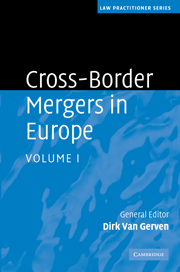Preface
Published online by Cambridge University Press: 03 May 2010
Summary
The Cross-border Merger Directive is the next logical step in creating a unified European market within which companies based in the European Union will be able to do business across borders without restriction. Indeed, the Crossborder Merger Directive sets out procedural rules to permit and facilitate the merger of companies situated in different Member States of the European Union and the European Economic Area. It is a useful addition to the Third Council Directive (78/855/EEC) of 9 October 1978, which governs mergers of public limited liability companies situated in the same Member State.
The Cross-border Merger Directive defines the consequences of, and the procedure for, a cross-border merger. The main consequence is that all assets and liabilities of the acquired company are transferred by operation of law to the acquiring company. The Directive sets forth procedural rules for three types of mergers, i.e. the absorption of one or more companies into a surviving company, the merger of two of more companies into a newly formed company, and the merger of a wholly owned subsidiary into its parent company, for which a simplified procedure applies. With respect to procedural aspects, the Cross-border Merger Directive refers to a large extent to the Third Council Directive, which sets forth procedural rules for purely domestic mergers, i.e. between companies situated in the same Member State. Since the Third Council Directive has been implemented in all Member States, implementation of the Cross-border Merger Directive has been greatly facilitated.
- Type
- Chapter
- Information
- Cross-Border Mergers in Europe , pp. ix - xPublisher: Cambridge University PressPrint publication year: 2010

